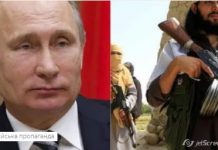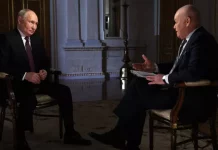
On July 12 Russia’s main state television channel, Channel One, interviewed a Ukrainian woman with a heart-wrenching story. The woman said she had witnessed the public execution of a 3-year-old boy, who was crucified in the crowded main square of Slovyansk in eastern Ukraine. The town had been a rebel stronghold but was retaken by the Ukrainian army a week earlier—and that’s when the execution took place, the woman said. Viewers of the prime-time news program were told that the Ukrainian “animals”—descendants of the fascist collaborators during World War II—cut the little boy’s flesh and made him suffer for an hour before he died. The woman added that the boy’s mother was then tied to a tank and dragged until she too was dead.
The Russian correspondent shook her head compassionately. “Are you not afraid to tell us this story?” she asked the woman three times, without trying to verify the facts.
Just as well—there weren’t any facts. The story was fake. As fake as the stories reported in Russia about the Ukrainian fascists who staged a coup in Kiev in February and then attacked the Russian-speaking southeastern Ukraine. As fake as some of the supposedly indigenous separatist leaders. The rebels’ self-styled defense chief, Igor Girkin (aka Strelkov, or “shooter”), for instance, is a former or maybe even current Russian security-services officer with a passion for theatrical re-enactments of battles in the post-1917 civil war.
The narrative of the civil war in Ukraine was scripted in Moscow and executed by state television channels that have substituted reality with fiction. The consequence of this fiction is the spilling of real blood and death, including the deaths of the 298 people on board Malaysia Airlines Flight 17.
Since the Moscow-backed annexation of Ukraine’s Crimea region, the virtual reality created by Russian state media has played a primary role in the conflict, backed by Russian military and intelligence. The first thing that the Russian special forces did in the Donbas region at the beginning of the war was to seize the television transmitters. Ukrainian channels were taken off the air and replaced by Russian state channels.
The Russian broadcasts skilfully played on fears and prejudices in eastern Ukraine against the political revolution in Kiev. The revolt overthrew President Viktor Yanukovych, a corrupt authoritarian who came from eastern Ukraine. And the Russian broadcasts exploited nostalgia in that part of Ukraine for the Soviet past. Some responsibility for that nostalgia’s persistence lies with Ukrainian intellectuals and political leaders, who failed in the post-Soviet era to build a law-based state or integrate Donbas into Ukraine.
Many of those who have joined the rebel movement see no benefit or virtue in Ukraine’s independence. Many are jobless and disenfranchised, some are paid pittances while risking their lives in illegal mines. Many of the separatist fighters are former Soviet soldiers who felt abandoned by their Soviet motherland. Russian television has brought them all together, calling them martyrs and heroes.
By contrast, the audience within Russia has been given the role of spectators. For six months Russians have watched a television serial filled with blood, violence and suspense. Every news program begins with a new episode of the Ukrainian war show. The show’s popularity can be seen in Mr. Putin’s approval rating, now over 80%.
The show has been free of charge, too: The feeble economic sanctions imposed by the West have so far not affected most of the Russian population. The Kremlin is fighting a proxy war aided by the TV remote control.
Yet the downing of Malaysia Airlines Flight 17 has changed the picture. This was clearly not part of the script. The crippling sanctions that Mr. Putin has so far managed to avoid are now a real threat. After the airliner was shot down, the smooth propaganda machine faltered briefly, sputtering out ridiculous stories that the Ukrainians shot down the passenger jet because they mistook it for Mr. Putin’s aircraft.
But then the propagandists settled on the official story: Flight 17 was shot down by the Ukrainian army with America’s knowledge and probably endorsement. Why would the U.S. do this? Because Washington wants to damage and isolate its Russian rival.
Why does the Kremlin’s propaganda seem more effective now than it was in Soviet days? Because it tells many people what they want to hear. Soviet crowing about the economic miracle of communism was daily refuted by empty stores and long lines. The advantages of capitalism and the West were too obvious.
The propaganda now fed to Russians is more sleek and professional than the drab Soviet version, but it is effective primarily because people want to believe it. It is depressing how many educated, middle-class Russians with access to alternative sources of information blindly rehearse the arguments made by state propaganda.
The war against Ukraine is now presented as a wider confrontation with the West and America in particular. In the Putin era, the collapse of the Soviet Union has been cast not as an act of liberation by its own people, but as a defeat imposed by the West. It is common to hear even young Russians—who have benefited from the oil boom in recent years and have no memory of Soviet life—disdain the West while they eagerly acquire the trappings of a Western lifestyle.
When the Soviet Union fell apart more than two decades ago, the central narrative was that Russia was on the path to join the West and share its values of freedom and democracy. With central planning replaced by a market economy, prosperity would bind Russia to the West. The paradox is that the richer Russians become, and the more they take vacations abroad, the more resentful they become of being judged by Western standards.
Kremlin propaganda has liberated Russia’s rich and powerful from the need to justify themselves to anyone and has freed them from a nagging inferiority complex. Russians are told relentlessly that theirs is a unique civilization, morally superior to the West. In identifying the U.S. as an enemy and the source of Russia’s troubles, the Kremlin sends the same basic message to Russians that it sends to the residents of eastern Ukraine: You are victims of outside forces.
Confrontation is embedded in the Putin regime and comes at the cost of not modernizing the country. As the Soviet Union once proved, this road leads to a dead end, but as Mr. Putin’s reckless behavior shows, it can spring nasty surprises along the way.
By Arcady Ostrovsky, the Moscow bureau chief at the Economist.





